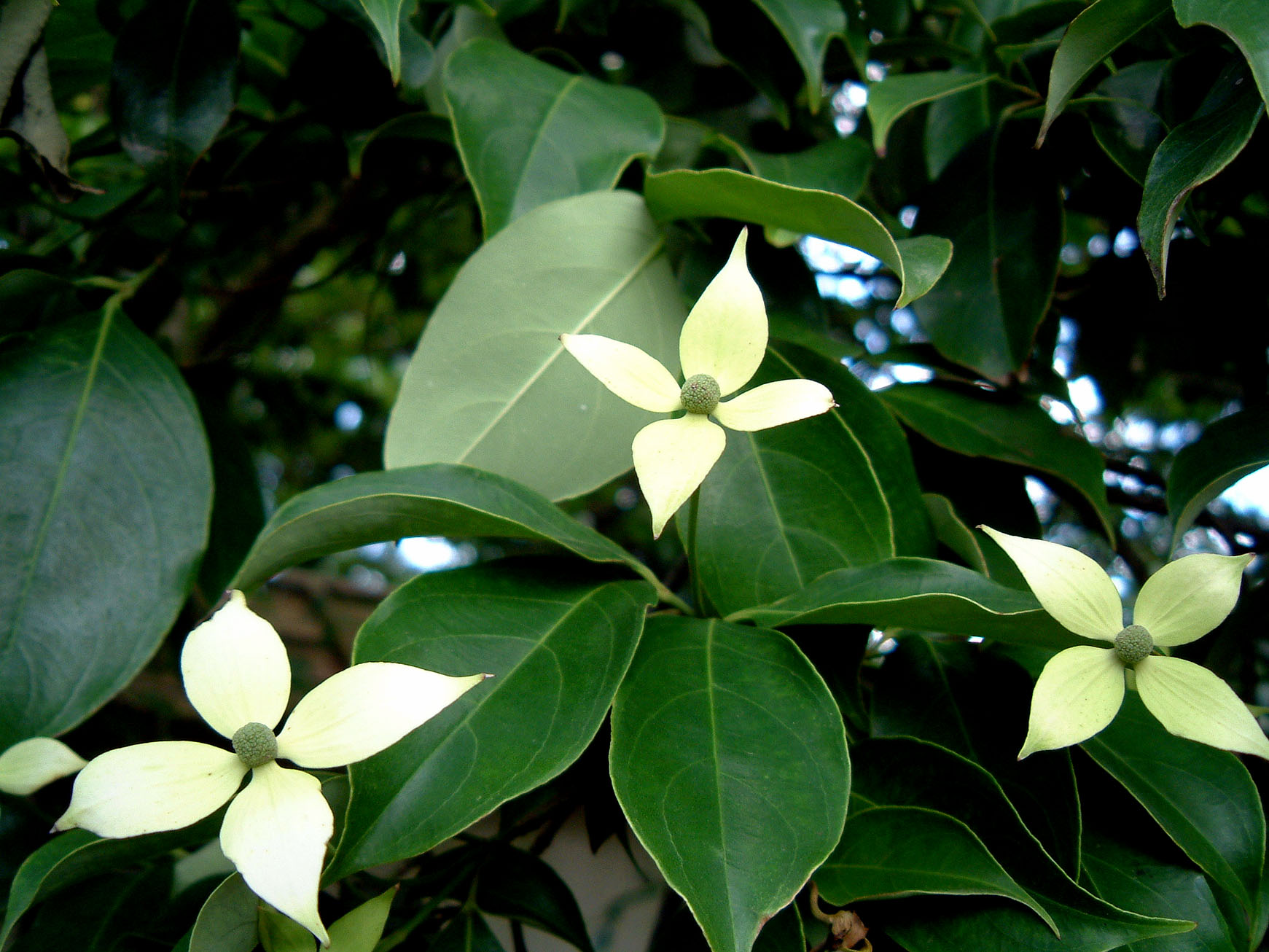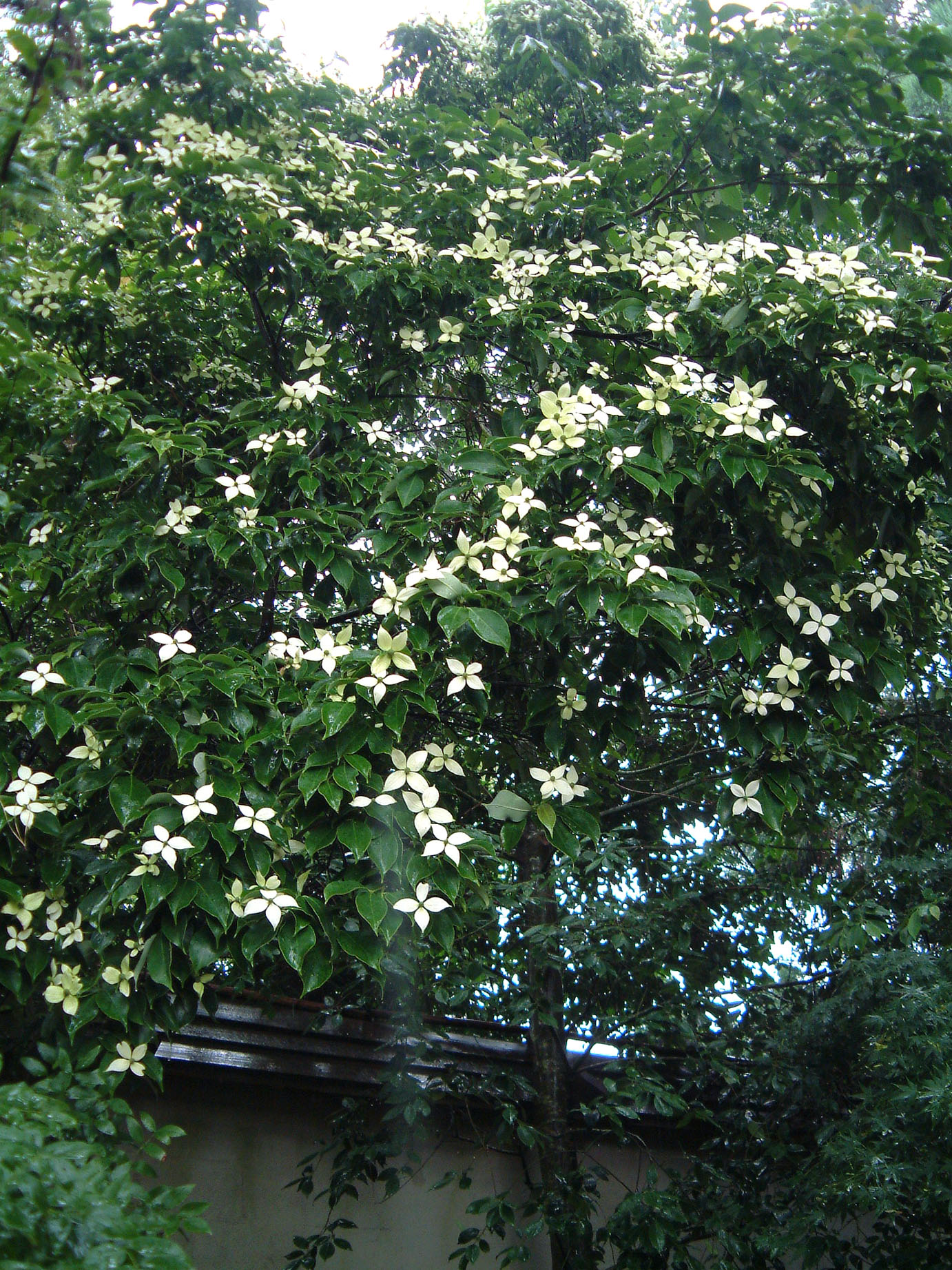NOS
CORNUS
ELLIPTICA
(angustata)
PAGEclick images
below to enlarge |
Copyright
2003-2005. Laurence C. Hatch. All Rights Reserved.
All downloading, printing, saving to media, or offline
use is prohibited.
Duplication by any means is unlawful.
Do not link to this page. |

original
tree of 'First Choice'. Raulston Arboretum. Summer 2003. Click image. If
you read the cultivar descriptions below you may note they all pretty
much have the same reason for being - vigorous, truly evergreen,
floriferous, rootable, and more cold hardy. Trials of these are ongoing
various places and we suspect that some regions will come to prefer one
over another.
Note the
very long peduncles (flower stalks) in this photo. This is one way to
tell the thing from C. capitata but also serves horticulturally to make
the flowers "pop" from under the foliage. That is a species plus here.
However, C. elliptica does not (as I write this May 2005) yet give us
the bright orange and purple new growth of C. capitata. We hope someone
can combine the best of each sometime and still preserve the dark, crisp
winter green foliage. LCH. |
This remarkable
cousin of Cornus kousa (formerly called var. angustata) is
correctly a distinct species. The late Dr. Ted Dudley, taxonomist at the
US National Arboretum, wrote to this effect and felt the best, oldest,
valid name was Cornus angustata. Stlll nurserymen are going with it the
wrong old way. It is a flowering arborescent dogwood that is evergreen
to semi-evergreen depending on one's climate. As seen here at the
Raulston Arboretum, this magnificent species has thick, dark green
leaves that feel and look very substantial. They retain some of the
arcuate, textured venation of the deciduous species.
Since the work of
Dudley and others, the Flora of China has been published for the
Cornaceae with substantial, original revisions to the species
concepts that demand our attention and respect. Specifically this work
is cited as:
Xiang, Q.Y. and
D.E. Boufford. 2005. Cornaceae. Flora of China: 14: 206-221. Harvard
University.
The formal and
correct new name for this evergreen entity is now:
Cornus
elliptica (Pojarkova) Q.Y. Xiang & Boufford
It is based on
the name Cynoxylon ellipticum of Pojarkova published in 1950
(gender ending adjusted ), the oldest known good epithet at the species
level. The epithet angustata AT THE SPECIFIC (SPECIES) LEVEL is
more recent and thus excluded. It has been somewhat controversial in
taxonomy to rename plants based on older names coined by Russian authors
whose works were not until recently known in the West (among them Dr.
Dudley and the entire western Cornus-loving community) and may not
quality as worldwide publication by botanical standards. That point
noted, we feel that the uniformly high quality of Drs. Xiang and
Boufford work (together with rigorous Harvard review standards) to merit
faith in their decisions and go with them. In general, I like to always
use the names of country or region's authoritative flora unless some
more recent paper present more compelling and fresh evidence to the
contrary. Go with the Floras of China, North America, and Europe
whenever you can.
Compared to
Cornus kousa var. chinensis, the bracts
immediately differ from the Kousa in being much narrower, rarely
overlapping, and quite acuminately pointed. In this example they are
very small with a diameter of the entire inflorescence of only 2 inches
or less. The central, globose cluster of true flowers stands out like it
was glued on for decoration. It is a very appealing flower from any
distance. |

Distance
view of the same tree above. |
The species is less
cold hardy than C. kousa at USDA 7 and perhaps some of zone 6. Claims of
zone 5 reported in places seem doubtful as no evidence has been brought.
It gets some odd winter discoloration in some areas and wind damage.
'Prodigy' (see below) reportedly has no odd winter tints of red and
purple shades. A bit of protection and shade for young plants is a good
idea. Heat tolerance is reported as being good and perhaps this is the
equivalent of Cercis canadensis subsp. texensis (mexicana) for the
dogwood world.
You can see from
this photo is less floriferous than your average modern, improved Kousa
cultivar. That is not a bad thing I think. The balance of the dark,
leathery leaf and the pale bracts should be maintained at around 50:50.
That dark, textured background has a great foil for these refined little
stars.
It should be
noted that Cornus elliptica is more similar to C. capitata
than the C. kousa in any of it's deciduous phases. There are wild
intermediates between C. elliptica and C. capitata but it
is not yet known if they are hybrids or just little known links in what
could become one larger species concept. DNA work will have to be done
on the wild taxa before we can lock down either species to a degree we
now find necessary. Using the characters in the key by Jenny Xiang and
David Boufford we can construct this chart:
|
TRAIT |
CORNUS ELLIPTICA |
CORNUS CAPITATA |
|
Peduncle thickness |
thin |
thick |
|
Peduncle length |
5 - 8 (10) cm |
2 - 3 (5) cm |
|
Infructescence shape |
near perfect globose |
compressed or
flattened globose |
|
Leaf veins below |
not pitted |
often pitted |
|
New foliage color |
light green to
greenish-purple as cultivated (to date) |
many seedlings rich
orange to purple shades, especially in garden clones |
LCH |